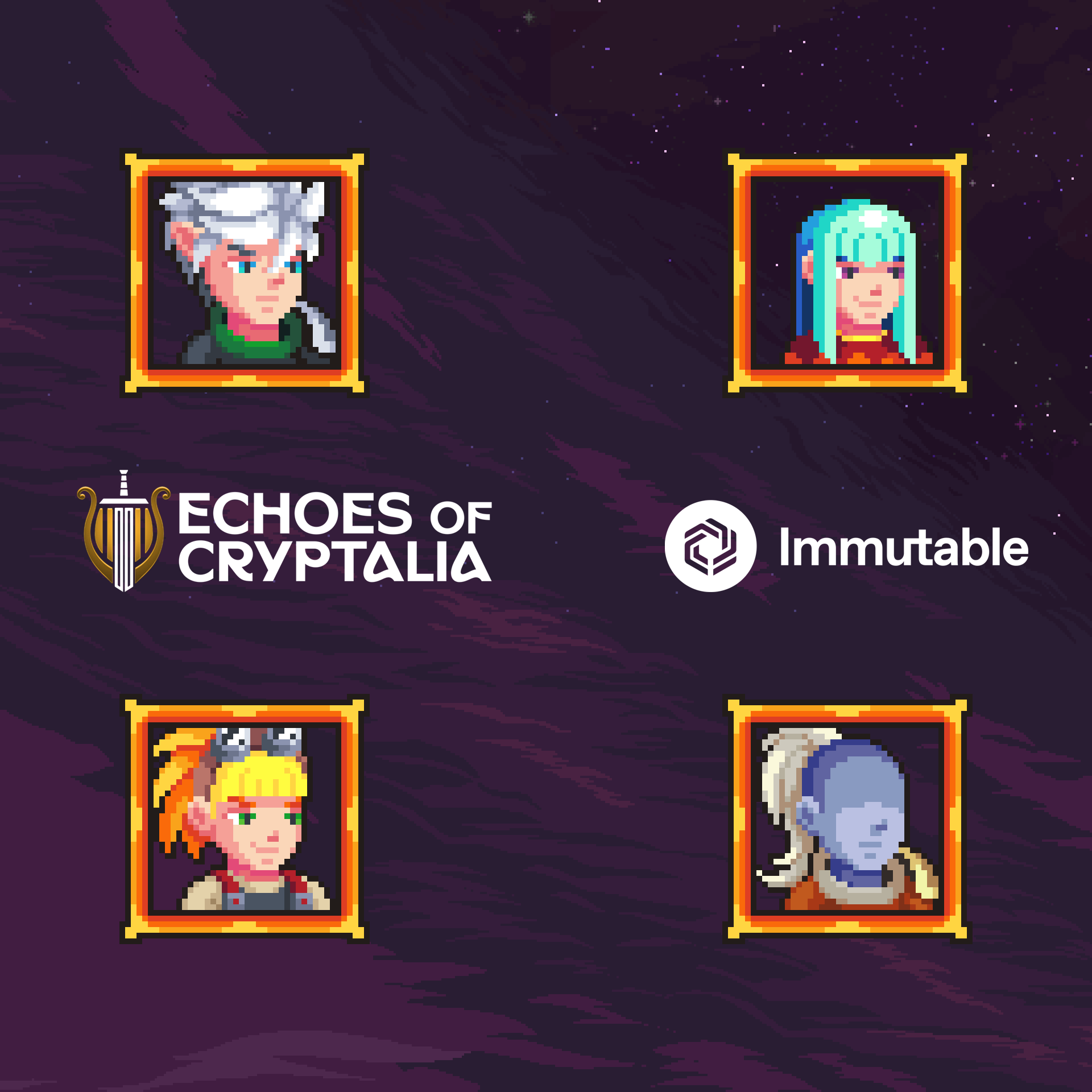Are you ready?
Yes, I know: We’ve taken longer than we expected to reveal our 3v3 Combat Spectacle. This feature is important for everyone, mainly because it plays a fundamental role in the $ECHO earning loop of our game. But, also, it’s where we can finally see our Loyalty Program Heroes fight and perform beautiful, terrible Chants.
I will not spend time explaining how many difficulties we have had to face, nor will I waste time praising our team for the way we have managed to get through despite the many setbacks that, like raging waves, have lapped against our humble vessel time and time again.
Battle tested, rough days, grinding gamers… you know the song.
I came here to talk about Echoes of Cryptalia’s Combat Spectacle and that is what I’m gonna do. But, before we dive into it, let me clear off some questions that the great minds of The Phalanx of Echoes have raised during our Loyalty Program Minigame.
First, it’s true that being a Holder of our Genesis Unbreakable Oaths allows you to get $ECHO during our Loyalty Program through battles. But this does not mean that you need a Genesis Unbreakable Oath to participate in the Loyalty Program or to play & enjoy our 3v3 Combat Spectacle. The pool of 1M $ECHO allocated to our Holders during this stage of the Loyalty Program is separate and distinct from the 1M $ECHO we have allocated to those who participate for free in Chapter 2 of our Loyalty Program.
Now, what we came for: LET’S FUCKING GO!
Select your Battle Team
First of all, you need to select your Battle Team. For this, you’ll have to choose 3 of the 4 Heroes that we presented to you at the beginning of this Chapter.
To enter the Party Manager go to the Quests section. There, you’ll find a button that reads “Select your Battle Team”. The Party Manager will look like this:
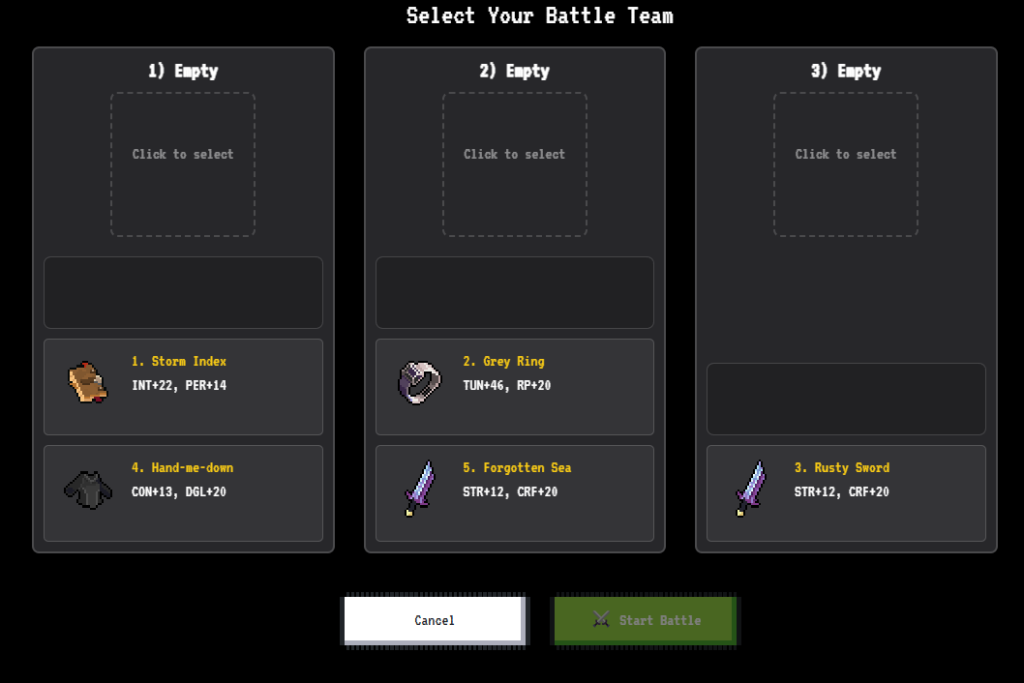
The Party Manager has 3 boxes in which you can place your Heroes. As you can see, these boxes have equipment assigned to them. The equipment available forms from the Gear you use against SHRIEKS in the Gear section. Thus, your items in slots 1 and 4 are assigned to the first Hero you choose. The same happens with the items in slots 2 and 5 for the second Hero. Finally the items you have in slots 3 and 6 will be for your third Hero.
As you may have noticed, the bonuses that the items deliver in combat are different from the bonuses that the items deliver in the fight against the Shrieks. Another & even more important detail is the following: The bonuses that an item delivers depend on the family it belongs to and not on its Tier. Thus, just as “Forgotten Sea” and “Rusty Sword” deliver the same set of bonuses, all helmets deliver the same set of bonuses, and so on. This is the case for each item family.
It’s important to note that as we monitor the impact that items have on the Combat Feature, their stats will be adjusted LIVE to achieve a balance that allows a greater number of competitive builds. This way, we’ll enable the greatest possible number of strategies available to players. Remember: We are BUILDING IN PUBLIC and it’s better to work on your adaptability than to waste time complaining because you won’t try and adapt together, as a single unit, with The Phalanx: there’s no easy and smooth path to the top of the leaderboard. Before anyone of you even think of opening tickets about it let me tell you: FAIR IS FAIR, and we’re tossing you all to the same open sea to find your way to land. Chop Chop and start swimming! Hahaha!
Hero Selection
As you can see, there’s an empty space with the text “Select Hero”. That’s right, you have to click to select. Then you’ll be able to see this panel:
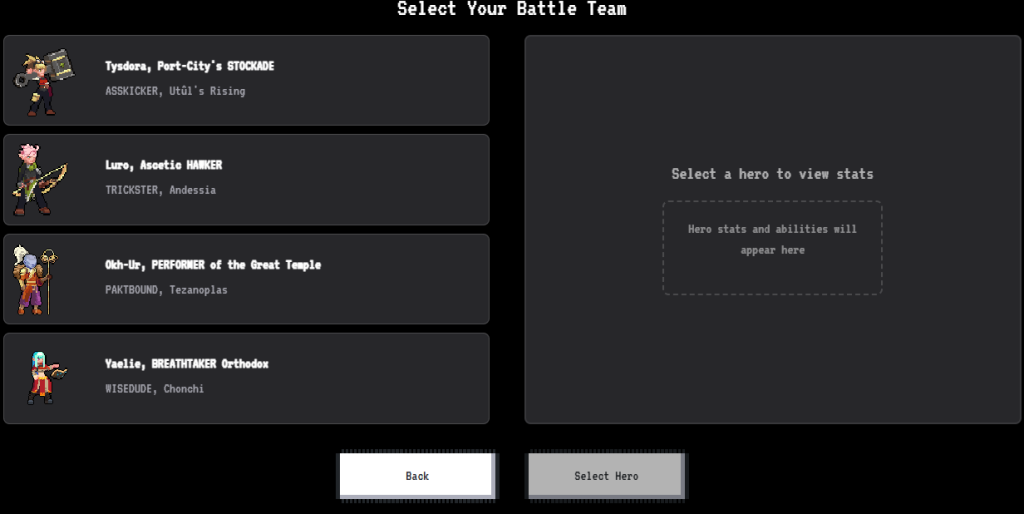
All four Heroes are here, waiting for you to select them!
Every Hero shows you their basic identity information: Name, Class. Then, under their Name, you’ll find their Macroclass and Hometown.
Now you know the names of the 4 Hometowns that inhabit the 10,000 Heroes of the GENESIS Collection! Also, at least 4 of the classes that we’ll find among the Heroes who heed the call of their Unbreakable Oaths.
If you click on any of the Heroes, you’ll see their Performance Stats, their Resistances, their Chants, and a little description of their character in a panel like this:
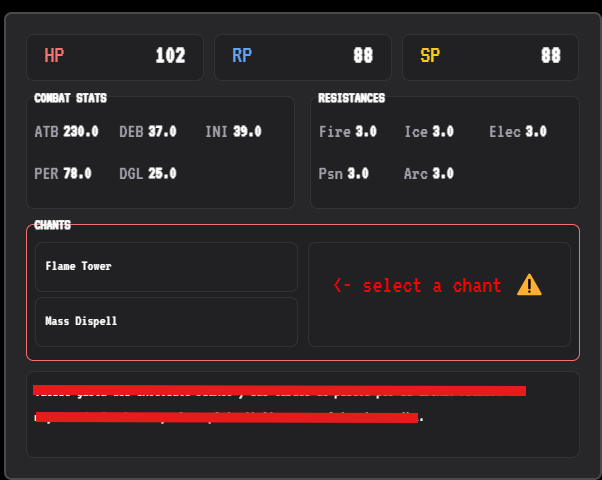
- HP (Hit Points): The health of your Hero. If this reaches zero (0) during the battle, the Hero is defeated and one of their companions has to take their place. The HP of a Hero is determined by all their Base Stats.
- RP (Resonance Points): In Echoes of Cryptalia, whenever someone performs a Chant, their own existence reverberates and resonates along with reality. RPs represent the maximum amount of energy the Hero can endure this way. After that, performing additional Chants will damage their HP. In other words, each Hero starts the combat with Zero (0) RPs. Each time they perform a Chant, they receive an amount of Resonance Points determined by the Chant’s cost. Whenever a Hero reaches their FEEDBACK threshold (in this example it’s 88), they will start taking damage each time they receive RPs. The FEEDBACK threshold of a Hero, shown here as RP, is determined by all the Base Stats of the Hero.
- GRIT: This is a concept that refers to the determination, courage and resilience to face difficulties and move forward. It’s a combination of passion and long-term perseverance. GRIT, more than an important piece of our game, is a loud statement from our team. For those who believe they’ll see us fall after a couple of misfortunes, let them learn this: Open Sky Games has GRIT.
That said, GRIT is an indicator of your Hero’s capacity of fighting the good fight, taking hits, getting tired AND STILL PUSH FORWARD. There are actions in the game that require you to use GRIT. When it runs out, you can spend turns resting and recovering. A Hero’s GRIT is determined by their Strength (STR), Constitution (CON), Focus (FOC) and Wisdom (WIS). - ATK (Attack): This is a combat stat that depends on the strength (STR), dexterity (DEX), focus (FOC), wisdom (WIS) and intelligence (INT) of the Hero. I’ll explain its use later in this article.
- DEF (Defense): This is a combat stat that depends on the dexterity (DEX) and focus (FOC) of the Hero.
- INI (Initiative): This is a combat stat that depends on the focus (FOC), dexterity (DEX) and intelligence (INT) of the Hero. Each turn, Heroes make a dice roll & add the result to their Initiative to determine who acts first.
- PER (Performance): Represents how skillful a Hero is at performing a Chant. This stat depends on the Hero’s Intelligence (INT), Charisma (CHA), Volume (VOL) and Tuning (TUN).
- DGL (Dodge Level): How skillful a Hero is at dodging a strike to avoid damage. A Hero’s DGL is determined by their Dexterity (DEX), Focus (FOC) and Luck (LCK). DGL is used together with DEF to determine a Hero’s Defense Status.
- Resistances: Poison, Ice, Fire, Electric or Arcane. Every Hero has a resistance layer for each of these elements. These layers depend on the Hero’s Constitution (CON) and Focus (FOC). You should know that the in game objects and effects that interact with this aspect of the characters do it by granting new Resistance layers or deleting the existing ones. Multiple layers of resistance of a particular element do not add up: they combine to form a single instance of harm reduction.
- Chants: Each Hero has access to 2 Chants. You must choose which one to carry to go into battle.
- Lore Inscription: Finally, you can read a little about the Hero you have chosen.
ATK Status vs DEF Status
Whenever a Hero attacks, their ATK Status is compared with the opponent’s DEF Status. If the ATK is equal to or greater than the opponent’s DEF, then the attack successfully hits and the damage the defender the game calculated the damage received. If the Hero’s ATK is lesser than the opponent’s DEF, the defending Hero manages to avoid the damage and loses a small portion of their GRIT.
ATK Status is determined by a mathematical function that uses ATK, Luck (LCK) and the result of the dice rolled by the attacker. DEF Status, on the other hand, is calculated by a mathematical function that uses DEF, DGL (Dodge Level), Luck (LCK), GRIT and the result of the dice that the defender rolled.
I RECCOMEND that, unless you are a deeply competitive player, DON’T WORRY TOO MUCH ABOUT THE FORMULAS. The game is designed for you to not need to calculate to make decisions. Every RPG has intricate Formulas running behind, but you didn’t notice while gaming Final Fantasy, Pokémon, Persona or Chrono Trigger, even Stardew Valley. You won’t notice in Echoes of Cryptalia. JUST GAME.
Resistance Layers
When a character has a single layer of resistance to an element, it reduces the damage received by that percentage. That is, if I have 3% Resistance to fire and 100 points of fire damage will be inflicted on me, then I receive 97 damage.
On the other hand, when a character has multiple layers of resistance to an element, these layers are applied consecutively, one after another. That is, if a character has one layer of 20% resistance to poison and another layer of 50% resistance to poison. Then, when this character is assigned a damage of 100 poison, we apply the first layer which subtracts 20 points of damage. Then, the 80 points of damage that are assigned after passing through the first layer receive the application of the second layer, thus reducing 40 points of damage. Thus, by grouping 2 Poison Resistances of 20% and 50%, the result is that I receive 40% of the total assigned damage.
How to read a chant

The description of a Chant is written in plain, simple terms. When the Chant has the ability to change the status of a combatant, you will see the affected things in the end of the description. Here, f example, we can see that the victims of Flame Tower receive a “Severely Scarred” status, which consists of a penalty to Constitution (CON) and Charisma (CHA).
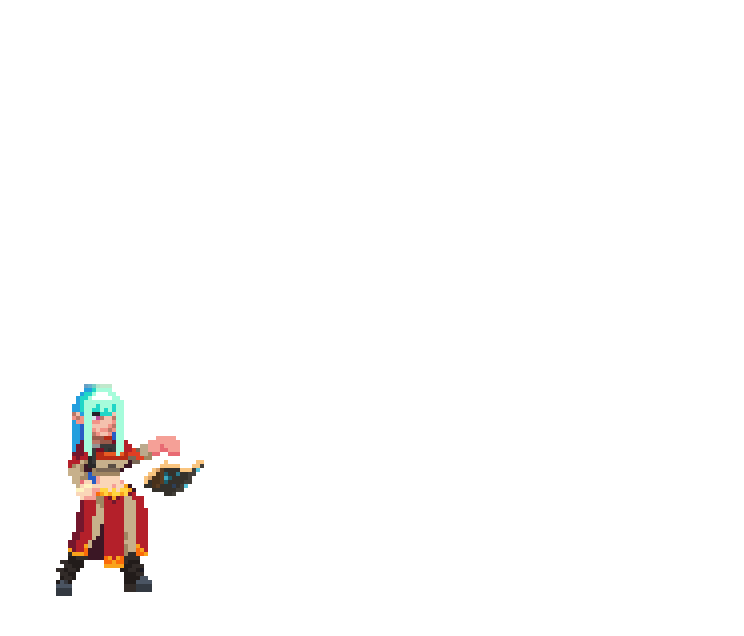
We can also see that victims of Flame Tower are affected by one of the 3 Basic Status that I’ll explain today: Bleed, Burn & Poison.
Bleed
You can identify a bleeding combatant because they will read: Bleed(X). Bleeding inflicts X damage each time combatant attacks or moves. Each time a Combatant bleeds, X is reduced by 1. When Bleed=0, it will disappear. Healing cures this status.
Burn
Whenever a combatant is Burned, it’ll show as: Burn(X). When a turn ends, a burned combatant has a 33% chance (1/3) of receiving 2 times X damage, a 33% chance (1/3) of receiving X damage, and a 33% chance (1/3) of reducing X by 1. Burn will be removed when X reaches zero (0) or if Healed.
Poison
Whenever a combatant is Poisoned, it’ll show as: Poison(X). They’ll take X damage at the end of their turn. Poison can only be removed through Antidote.
Other Status
Other statuses such as Fortitude or Fear continuously affect the bearer’s stats and can last for a certain number of turns or until the bearer performs a certain number of attacks. When a Chant includes one of these statuses it will specify in brackets which stats it affects. The magnitude of the impact of a chant in general depends on the Performance (PER) stat of the chanter.
Well. There’s a lot more to explain about the game, but I think this is enough for today — I don’t want to confuse you with too much info. But now you should have a much clearer idea on how our 3vs3 Combat Spectacle works, so you can learn and take the most advantage for the 1M $ECHO rewards that await GENESIS Unbreakable Oath Holders by winning in the Alpha 0.1 version that we’ll implement in our Loyalty Program.
Don’t miss the activities: JOIN THE PHALANX in our Discord.
GAME’S ON!
